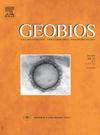下白垩统下沟组一种新的异鸟目动物(鸟类目:鸟胸目),短毛异常
IF 1.6
4区 地球科学
Q2 PALEONTOLOGY
引用次数: 0
摘要
本文描述了中国西北地区下白垩统下沟组昌马地区的一种异鸟目恐龙的部分骨架。该标本暂定为胃颗粒。该标本保留了一个与坐骨长度近相等的异常短的耻骨,这是反鸟目动物中的一种自异形,证明了一个新分类单元的建立,Novavis pubisculata nov. gen., nov. sp.耻骨的缩短长度表明该物种的腹腔比所有其他已知的反鸟目动物都要短。虽然有几块肌肉与耻骨相连,但耻骨和尾椎之间的距离增加以及随后这些肌肉的延伸可能对耻骨内肌和耻骨外肌的功能影响最大。对于冠鸟来说,这将导致这些肌肉收缩速度的降低,这些肌肉在尾翼扇动中起作用,因此在起飞和降落过程中对飞行很重要。虽然短耻骨的潜在功能和腹腔大小的变化尚不清楚,但在反鸟鸟中普遍缺乏气动尾部肌肉组织和羽毛,这可能减轻了限制这些肌肉长度的压力,因此通过短耻骨延长这些肌肉并不会损害这些鸟类的气动能力。本文章由计算机程序翻译,如有差异,请以英文原文为准。
A new enantiornithine (Aves: Ornithothoraces) from the Lower Cretaceous Xiagou Formation with unusually short pubes
We describe a partial skeleton of an enantiornithine from the Changma locality of the Lower Cretaceous Xiagou Formation in northwestern China. The specimen is tentatively interpreted as a gastric pellet. The specimen preserves an unusually short pubis that is subequal in length to the ischium, an autapomorphy among enantiornithines, justifying erection of a new taxon, Novavis pubisculata nov. gen., nov. sp. The abbreviated length of the pubis suggests that the abdominal cavity in this species was proportionately shorter than in all other known enantiornithines. Although several muscles attach to the pubis, the mm. pubocaudalis internus and externus were probably the most functionally impacted by the increased distance between the pubes and caudal vertebrae and subsequent elongation of these muscles. In crown avians this would result in a decrease in the contraction speed of these muscles, which play a role in tail fanning and are thus important for flight during take-off and landing. Although the underlying function of the short pubis and changes in the size of the abdominal cavity are unknown, the widespread absence of aerodynamic tail musculature and plumage in enantiornithines may have relaxed pressures constraining the length of these muscles, such that elongation of these muscles through a shortened pubis was not detrimental to the aerodynamic abilities of these birds.
求助全文
通过发布文献求助,成功后即可免费获取论文全文。
去求助
来源期刊

Geobios
地学-古生物学
CiteScore
3.30
自引率
6.20%
发文量
28
审稿时长
6-12 weeks
期刊介绍:
Geobios publishes bimonthly in English original peer-reviewed articles of international interest in any area of paleontology, paleobiology, paleoecology, paleobiogeography, (bio)stratigraphy and biogeochemistry. All taxonomic groups are treated, including microfossils, invertebrates, plants, vertebrates and ichnofossils.
Geobios welcomes descriptive papers based on original material (e.g. large Systematic Paleontology works), as well as more analytically and/or methodologically oriented papers, provided they offer strong and significant biochronological/biostratigraphical, paleobiogeographical, paleobiological and/or phylogenetic new insights and perspectices. A high priority level is given to synchronic and/or diachronic studies based on multi- or inter-disciplinary approaches mixing various fields of Earth and Life Sciences. Works based on extant data are also considered, provided they offer significant insights into geological-time studies.
 求助内容:
求助内容: 应助结果提醒方式:
应助结果提醒方式:


